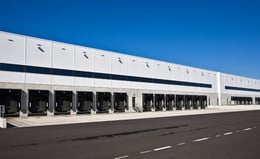5 Ways Manufacturing Companies Can Strengthen Their Supply Chain
Nick Ostdick - July 04, 2017

Let’s play a game: Imagine a genie appeared before you and granted you five wishes for helping your manufacturing company improve and strengthen your supply chain. While you can’t wishes for more wishes, you can wish for anything and everything from enhancing the efficacy of your sales and operations planning platform to your transport logistics strategy. The trick question is: What do you wish for? What actions can you take that would holistically improve your overall supply management and logistics scheme while at the same time bolstering your productivity from procurement of materials to the delivery of the final product?
The genie element of the exercise is of course completely impractical, but the real-world implications of this exercise are something production planners and managers grapple with on a daily basis. In a such a growing, competitive industry, there’s so many voices, opinions, and recommendations companies must sift through in deciding how to enhance their supply and production processes and where they can afford to take value-added steps and where they cannot.
Add to the mix rapidly advancing technologies and manufacturing companies can quickly find themselves struggling to determine their logistics priorities and the steps necessary to address those priorities.
While we don’t have access to our genie in a bottle, we do have the ability to examine and discuss five critical ways manufacturing companies can strengthen their supply chains and what the impact of these actions are on a company’s entire value stream.
1. Ditch the spreadsheet
We’ve discussed before on this blog how manufacturing must move beyond the spreadsheet or Excel models and embrace the digitization of the supply chain from the sales and ordering stages through production and logistics. Not only does working with a centralized, integrated planning and production solution break down functional silos in a cross-organizational manner, but it also makes it easier for manufacturing companies to gather, sort, and analyze data — an element of modern supply chain management that is crucial for success in a global environment. A reliance on spreadsheets makes a manufacturing company stiff and less agile because visualization, what-if scenarios, and other methods of predictive planning are difficult to engage in via static data sets. Ditching the spreadsheet means incorporating more dynamic data sets and provides companies the agility and end-to-end (E2E) visibility necessary to adapt to a variant-rich supply stream.
2. Selecting the right technology solution
Today’s supply chain management is not a one-size-fits-all proposition. Different manufacturing companies with different manufacturing needs require different suites of intelligent planning and reporting solutions in order to operate as effectively as possible. Simple as this may sound, many companies still don’t fundamentally understand the ins and outs of their production and supply processes and thus don’t have the insight necessary to select the right solution for their needs. For example, a company with a single production hub may not need as robust a transport logistics solution as a company with multiple hubs across a wide range of regions. On the other hand, a company with multiple production sites would not benefit from a less powerful or optimized job allocation solution as the company with the single production site. Understanding how and why your supply pipeline functions is critical in choosing the right technology to supplement and enhance your operations.
3. Integrate S&OE and S&OP
It’s common knowledge that S&OP gives manufacturing companies the ability to effectively plan, coordinate, and organize between sales, procurement, and production in the short-term - anywhere from a few weeks to a few months ahead of time. But what if manufacturing companies could engage in this same process on a daily level in order further optimize their production schemes and gain greater, real-time insight into their supply situation? Best of both worlds, right? This is where the value proposition is in integrating S&OE and S&OP strategy. In service of promoting micro-agility, manufacturing companies can now plan, adjust, alter, and act on planning and production sequences essentially day-to-day for a more reactive supply stream capable of weathering unforeseen disruptions or breakdowns.
4. Predict and mitigate disruptions
Whether it’s via real-time reporting and data gathering, forecasting, simulations, or putting Big Data to work to uncover patterns or trends, a manufacturing company in today’s global economy is really only as stable and productive as its ability to predict, mitigate, and combat the potential for disruptions or breakdowns. Because so many of the modern manufacturing landscape operates in concert with a variety of partner organizations in vast production networks, it’s imperative manufacturing companies have the capacity to understand moments when disruptions are possible and the steps necessary (altered job allocation, modified inventory management or movement, or adjusted transport logistics) to avoid these disruptions and create actionable planning to avoid similar future occurrences.
5. Strive for E2E visibility
While it’s seemingly been relegated to buzzword status, the push for E2E is alive, well, and critical for manufacturing companies. As we’ve discussed in recent entries, today’s manufacturing cycle is no longer comprised of disparate actions or departments working in silo-based systems where the events in one stage have no impact on the events in another. The holistic integration of the production process means manufacturing companies must now have an expanded field of vision from sales and procurement through delivery in order to successfully execute an efficient supply pipeline model. Through breaking down planning and function silos, incorporating integrated technology, and the coordination of planning and production department, manufacturing companies can achieve greater levels of E2E and overall productivity and profitability.
If you want to learn more, download your guide to Transformation of Manufacturing Processes.
In this Guide you will learn:
-
Emerging Challenges in the Modern Truck/Automotive Industry
-
How Can Global Companies Adapt to These New Realities
-
How Decentralized Digital Systems Power Smarter Planning Processes
-
How flexis Can Support Flexible Supply Chain Transformation
LATEST POSTS
- Understand Circular Economy in The Manufacturing Industry
- How Can Industry 4.0 IT Integration Be Achieved Smoothly?
- The Significance of Order Sequencing in Discrete Manufacturing
- How to improve your Supply Chain Management: The Power of Control Towers
- Optimizing Human Resource Scheduling in Manufacturing: A Technological Approach



